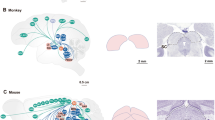Abstract
The total electrical discharges of the ventral and ventrolateral funiculi of the 11th thoracic segment of the spinal cord in response to stimulation of different points of the pons varolii and the medulla oblongata between frontal planes P-2 and P-12 were investigated in decerebrated cats. Regions were found corresponding to the location of the oral and caudal reticular nuclei of the pons and the rostral section of the reticular giant cell nucleus whose stimulation caused a short-latent discharge in the ventral funiculus (latent period 1.6–1.9 msec) with maximum amplitude. It was concluded that such a discharge is due to the direct stimulation of a rather homogeneous group of fast-conducting reticulo-spinal fibers which terminate mainly in the ventral funiculus and which have an average rate of conduction of 131 m /sec. When the same regions were stimulated, the short-latet discharge of the ventro-lateral funiculus had a considerably lower amplitude and was accompanied by a powerful, late discharge with a latent period of about 3.3 msec. It was assumed that this funiculus consists mainly of fibers with a lower rate of conduction which originate in a broader region of the medial RF of the brain stem. Stimulation of contralateral regions of the reticular formation of the medulla oblongata evoked only a weak short-latent discharge in the ventral funiculus; the late component of the discharge in this case was considerably stronger.
Similar content being viewed by others
Literature cited
A. Brodal, Reticular Formation of the Brain Stem [Russian translation], Moscow (1960).
N. N. Preobrazhenskii, I. S. Bezhenaru, and A. P. Gokin, "Monosynaptic exciting postsynaptic potentials in the thoracic motor neurons in response to reticulo-spinal effects," Neirofiziologiya,1, 243–252 (1969).
J. F. Rossi and A. Sanketti, Reticular Formation of the Brain Stem [Russian translation], Moscow (1960).
A. I. Shapovalov, "Extrapyramidal synaptic effects on the spinal neurons," in: Synaptic Processes [in Russian], Kiev (1968), pp. 215–230.
D. Bodian, "Spinal projections of brain stem in rhesus monkey, deduced from retrograde chromatolysis," Anat. Rec.,94, 512–513 (1946).
H. F. M. Bush, Anatomical Analysis of the White Matter of the Brain Stem of the Cat. Thesis, The Assen Bij van Gorcum and Co., New York-Leiden (1961), p. 116.
S. Grillner, T. Hongo, and S. Lund, "Monosynaptic excitation of spinal γ-motoneurons from the brain stem," Experientia,22, 691 (1966).
S. Grillner, T. Hongo, and S. Lund, "Reciprocal effects between two descending bulbospinal systems with monosynaptic connections to spinal motoneurons," Brain Res.,10, 477–480 (1968).
S. Grillner, and S. Lund, "A descending pathway with monosynaptic action on flexor motoneurons," Experientia,22, 390 (1966).
M. Ito, M. Udo, and N. Mano, "Long inhibitory and excitatory pathways converging onto cat reticular and Deiters' neurons and their relevance to reticulofugal axons," J. Neurophysiol.,33, 210–226 (1970).
S. Lund and O. Pompeiano, "Descending pathways with monosynaptic action on motoneurons," Experientia,21, 602–603 (1965).
R. Nyberg-Hansen, "Sites and mode of termination of reticulo-spinal fibers in the cat," J. Comp. Neurol.,124, 71–100 (1965).
J. W. Papez, "Reticulo-spinal tracts in the cat," J. Comp. Neurol.,41, 365–399 (1926).
R. E. Pitts, "The respiratory center and its descending pathways," J. Comp. Neurol.,72, 605–625 (1940).
K. Sasaki, A. Namicawa, and S. Hashiramoto, "The effect of midbrain stimulation upon alpha-motoneurons in lumbar spinal cord of the cat," Jap. J. Physiol.,10, 303–316 (1960).
A. Torvik and A. Brodal, "The origin of reticulo-spinal fibers in the cat," Anat. Rec.,128, 113–135 (1957).
M. Udo and N. Mano, "Descrimination of different spinal monosynaptic pathways converging onto reticular neurons," J. Neurophysiol.,33, 210–226 (1970).
W. D. Willis and F. Magni, "The properties of reticulo-spinal neurons," Progr. in Brain Res.,12, 56–64 (1964).
V. J. Wilson and M. Yoshida, "Vestibulo-spinal and reticulo-spinal effects of hindlimb, forelimb and alpha motoneurons," Proc. Nat. Acad. Sci. (Wash.),60, 836–840 (1968).
J. H. Wolstencroft, "Reticulo-spinal neurons," J. Physiol., London,174, 91–108 (1964).
Additional information
A. A. Bogomolets Institute of Physiology, Academy of Sciences of the Ukrainian SSR, Kiev. Translated from Neirofiziologiya, Vol. 3, No. 3, pp. 274–283, May–June, 1971.
Rights and permissions
About this article
Cite this article
Bezhenaru, I.S. Study of neuronal structures of the brain stem which produce rapid reactions in reticulo-spinal pathways. Neurophysiology 3, 205–212 (1971). https://doi.org/10.1007/BF01065494
Received:
Issue Date:
DOI: https://doi.org/10.1007/BF01065494




